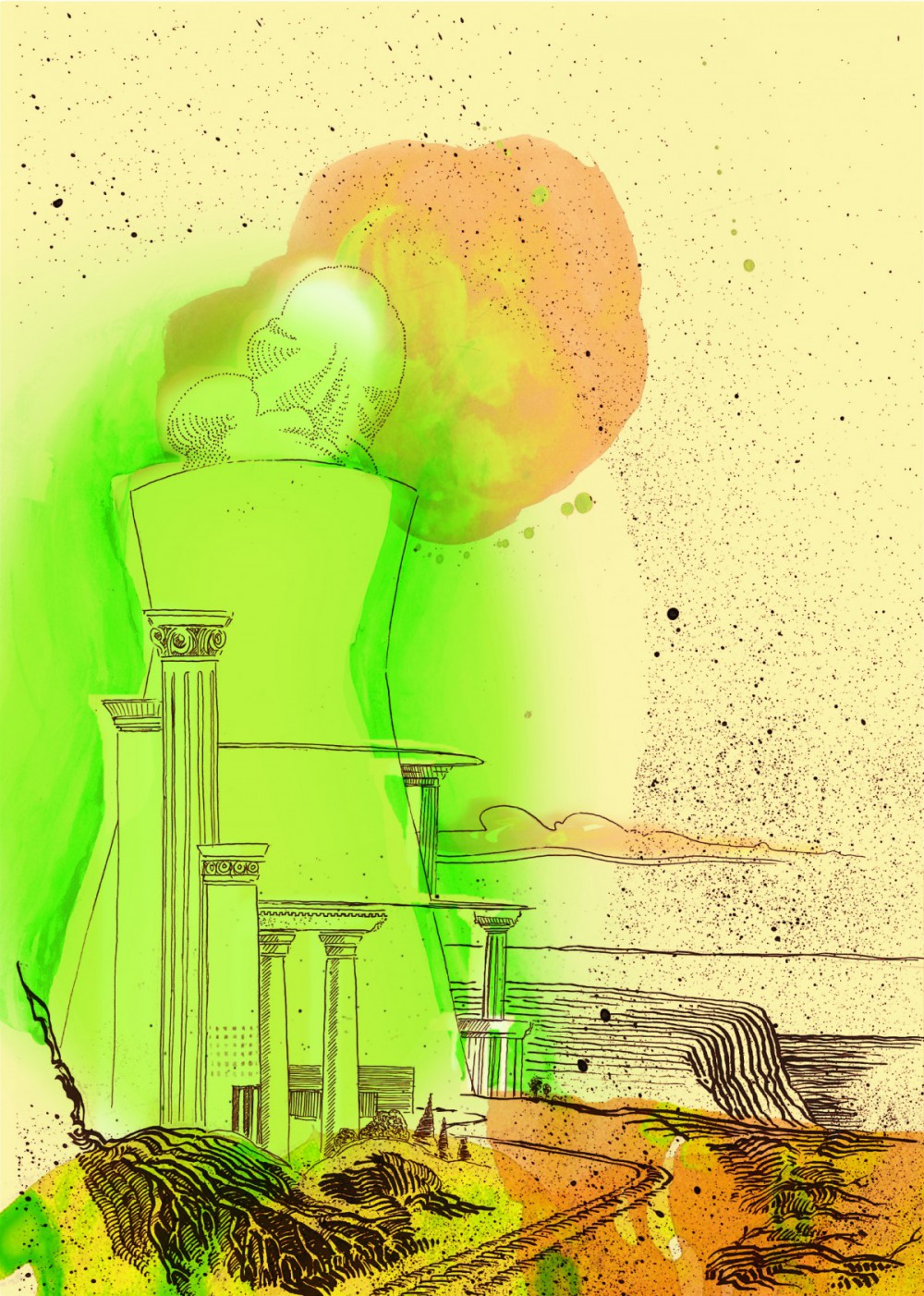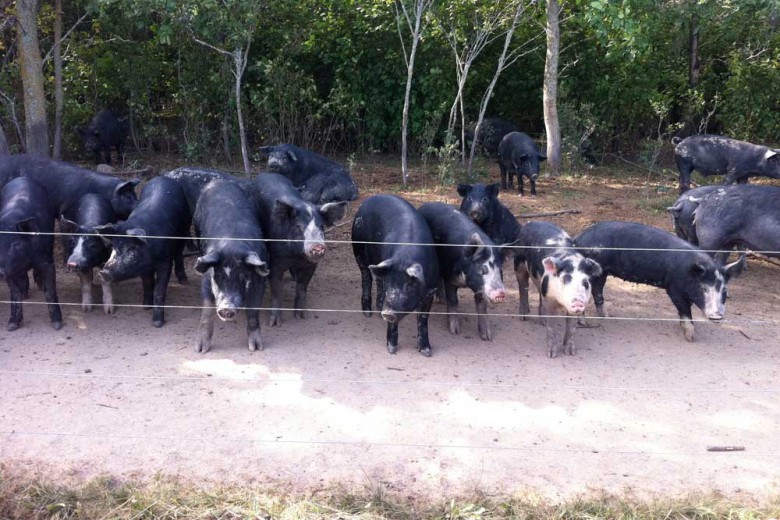
In 2011 the University of Saskatchewan went truly nuclear, realizing, in many respects, the loftiest ambitions of the uranium industry and its supporters within the provincial government and the university. On October 14, 2011, the University of Saskatchewan board of governors formally approved the incorporation of the Canadian Centre for Nuclear Innovation (CCNI) “to stimulate new research, development and training in advanced aspects of nuclear science and technology.”
Although the pieces seemed to come together in just a few short months, the game plan had been coalescing since Brad Wall’s Saskatchewan Party government was first elected in 2007 (read the full timeline here). Tracing corporate connections and developments behind the scenes shows how a coordinated strategy can be implemented largely outside public purview and beyond generally accepted public accountability.
Saskatchewan 2020: Powering the tarsands
Uranium development in Saskatchewan is nothing new. Tommy Douglas’ Co-operative Commonwealth Federation (CCF) government first encouraged uranium mining in the province in the 1940s, and successive NDP governments followed suit.
A proposal to establish a uranium refinery at the town of Warman was floated by Allan Blakeney’s NDP government in the late 1970s but shelved after a huge public backlash. Another 30 years passed before the newly elected Saskatchewan Party began to aggressively push the nuclear agenda once again.
Early in its mandate, Brad Wall’s government entered into discussions with Bruce Power of Ontario regarding the establishment of a nuclear reactor in the province. In June 2008, a joint feasibility study was announced between Bruce Power and the Crown corporation SaskPower, touting the benefits of “clean electricity” to replace the coal and gas power stations in the province. The proposed Saskatchewan 2020 program would investigate “how best to integrate nuclear energy, which produces no greenhouse gases when it produces electricity, with hydrogen, wind, solar and clean coal technologies to give Saskatchewan a diverse and secure supply of clean energy for 2020 and beyond.”
But clean energy was not the primary consideration. In fact, the proposal builds upon the dubious concept of using nuclear energy to power the extraction of oil from the Athabasca tarsands, oxymoronically termed “green bitumen” by the industry.
Bruce Power is two-thirds owned by Cameco Corporation and TransCanada Corporation, the latter of which operates the Keystone pipeline. It is therefore no surprise that the feasibility report, unveiled in November 2008, deemed there was sufficient demand for a nuclear power station in the province. The report states that “the growth in electricity demand in northeastern Alberta could provide a possible export market for Saskatchewan,” an allusion that could only refer to the tarsands. Thus the Saskatchewan 2020 nuclear power plan was launched.
In late 2008, as part of their strategy to implement the Saskatchewan 2020 plan, the government established the Uranium Development Partnership (UDP), comprising representatives from the nuclear industry, the University of Saskatchewan (U of S), and other supporters. It is striking that the only academic on the committee was designated its chair: Dr. Richard Florizone, a physicist and the vice-president of finance and resources at the U of S, who has long been a proponent of a nuclear research reactor on campus and presumably saw great potential for collaboration between industry and the university.
The UDP report, released in March 2009, contained 20 recommendations for nuclear development in the province, including one for the creation of a nuclear centre of excellence in Saskatchewan. Shortly afterward, the government announced a public consultation process on the UDP recommendations to be conducted that summer, which was an unexpected public relations disaster: fully 88 per cent of the 2,263 responses rejected the overall strategy of the report. Bill Boyd, then minister of energy and resources, was shaken but undeterred. Boyd interpreted the results to mean, “… it’s neither a green light nor a red light for future uranium development. It’s more like a yellow light – take any next steps with caution.”
Industry, government, and the university unite
What followed was a truly remarkable exercise in pushing the whole nuclear agenda under the political radar. Rather than slowing down and taking a cautionary approach, the government instead began assiduously advancing its program through the University of Saskatchewan, which was apparently a willing partner.
Through its rather clandestine agencies – the newly established Enterprise Saskatchewan and its twin, Innovation Saskatchewan – the government focused on promoting the concept of a U of S nuclear centre of excellence. The government also proposed a nuclear reactor at the university as the means for producing medical isotopes, even though the UDP report acknowledged that a reactor dedicated solely to that purpose would not be financially sustainable. Nevertheless, an application for federal funding was prepared in the summer of 2009 by the university and government. When the application was rejected a few months later, the strategy took off in yet another direction.
In 2010, a cabinet shuffle placed the provincial minister of advanced education, Rob Norris – who had been employed at the U of S from 1999 to 2007 and enjoyed a close working relationship with the university’s president, Peter MacKinnon – at the helm of Innovation Saskatchewan. Responsibility for the UDP was transferred from Bill Boyd to Rob Norris at this time as well. The realignment of cabinet appointments positioned Norris perfectly for synchronizing his industrial and academic agendas.
Enterprise Saskatchewan was also working hard behind the scenes to see the UDP agenda implemented. The university vice-president of research, Karen Chad, was added to Enterprise Saskatchewan’s board of directors, and Grant Isaac, senior vice-president of Cameco and former director of the U of S Edwards School of Business, joined the research, development, and commercialization sector team.

The confluence of industry, government, and university interests was quickly materializing. The concept of a nuclear centre at U of S came one step closer to reality in March 2011, when the provincial government announced a start-up grant of $30 million over seven years. By the end of March 2011, when the establishment of the Canadian Centre for Nuclear Innovation was announced, Enterprise Saskatchewan (ES) could boast in its annual report, “Eighteen of the 20 recommendations made by the Uranium Development Partnership – which resulted from an ES board recommendation – have now been implemented.”
A nuclear research centre is hatched
The formation of the Canadian Centre for Nuclear Innovation in October 2011 followed a highly restricted debate of the proposal at a meeting of the university council, comprising representatives from faculty and administration, a few weeks before. The university senate, the branch of university governance representing the community at large, was largely ignored in the process. USSWORD senators (University Senators in Saskatchewan Working to Revive Democracy) attempted to raise their concerns at the fall meeting on October 15, but the governors had already approved CCNI’s establishment – on October 14.
The CCNI business framework clearly states the expectations of the provincial government in funding the centre:
“… the province expects nuclear power to be considered in the range of energy options available for base-load generation capacity in the medium and long term after 2020, and that the CCNI will be able to serve as a source of expertise to inform decisions in this area.”
Although the CCNI will be a university subsidiary, concerns were raised about its governance structure at a university council meeting in September 2011. The university will directly appoint only two of the CCNI’s eight directors, raising questions about how much control the university will have over research priorities and how much control the government and its partners in the nuclear industry will exercise. With the announcement of the board in January 2012, the concerns appear to be warranted. The CEO of Innovation Saskatchewan and vice-presidents from Cameco Corporation and Atomic Energy of Canada Limited are among the appointees.
A gentle wooing
The readiness with which the university administration and faculty accepted the establishment of the CCNI comes as no surprise. One might conclude, after reading to this point, that there is an aura of inevitability about it. But in fact, the foundations for university support have been carefully built over several years. The uranium industry, and particularly Cameco – its chief manifestation here in Saskatchewan – have assiduously wooed the University of Saskatchewan and given millions of dollars in endowments to chairs, scholarships, and infrastructure over the past two decades. Cameco Plaza, next to the Administration Building, and Cameco Skywalk at Royal University Hospital, are among the most visible physical signs of this corporate impact.
Several of the faculty, directors, and department heads who wrote glowing letters of support for the establishment of CCNI have at one time or another seen their programs benefit from Cameco’s largesse. For example, days after the director of the International Centre for Northern Governance and Development at the U of S issued a fervent endorsement of the CCNI, a press release reported a $2 million grant to the centre, jointly funded by Cameco and the provincial government.
Moreover, the personal connections between the U of S and Cameco are well developed. Former university president J.W. George Ivany joined Cameco’s board of directors immediately after his term ended in 1999. Grant Isaac, former dean of the Edwards School of Business at the U of S, joined the Cameco board in 2009 and has been Cameco’s chief financial officer since 2011. Nancy Hopkins, another member of Cameco’s board, has been on the U of S board of governors since 2005 and its chair since 2010.
As further evidence of the cozy relationship between Cameco and the inner circle at the U of S, one might point to university president Peter MacKinnon’s excursion to Cameco’s northern operations and stay at its exclusive lodge on Yalowega Lake in August 2009. Hosted by then CEO Jerry Grandey, MacKinnon was flown in at company expense and treated to the haute cuisine of John Nater, lodge manager and world-class Swiss chef.
Making sense of the Land of Oz
After reviewing this brief history of collaboration between industry, government, and the university, one may be struck with a profound sense of the surreal. It is as though, like Dorothy, we are transported to an alternate reality, the Land of Oz. Here, all the talk is about the bright future of nuclear medicine and glittering isotopes. But go down the shady side path into the forest, and one encounters the dark underside of the nuclear agenda and its connection to tarsands extraction.
The labyrinthine network of corporate, government, and university connections represents continuing efforts toward the development of one or more nuclear reactors in Saskatchewan to power extraction of oil from the tarsands. All the while, the nuclear industry is also actively courting northern Saskatchewan communities to host a nuclear waste management site. Radioactive waste would be transported overland through populated areas from eastern Canada and beyond in order to get there.
In August 2011, Rob Norris announced that the provincial government and Japan’s Hitachi-GE Nuclear Energy Ltd. would each provide $5 million to the university for “a research partnership focusing on nuclear medicine, materials science, nuclear safety and small reactor design.” While nuclear medicine is always at the forefront in public announcements, the applied research and development interests of the nuclear industry are ultimately what drive the agenda. In other words, no matter how we negotiate the maze of corporate connections, retracing our steps along the yellowcake road always takes us back to the 2008 launch of the Saskatchewan 2020 plan.
Equally disturbing is the pervasive climate of corporatism that has crept over the University of Saskatchewan in the past two decades. Most academics dare not question or criticize the influence of the nuclear industry on campus. The rigorous discourse normally associated with academia is all but absent in this debate; the pall of corporate influence has nearly extinguished discussion and dissent.
Instead, the administration has mounted an aggressive campaign to discredit those who speak out. As an example, when concerns were raised about Nancy Hopkins’ apparent conflict of interest – serving both as a director of Cameco and the chair of the U of S board of governors – they were indignantly dismissed by both administration and board. Hopkins also chaired the search committee for the new university president, Ilene Busch-Vishniac, who will take office in July 2012. Many fear that it will be business as usual under the new president, given her record at McMaster University where she most recently served as provost.
The university administration is complicit, the faculty and staff are largely acquiescent, and the vast majority of students appear to be oblivious to the dangers of encroaching corporate influence. It has been left to a few faculty and students and a minority of university senators to raise the alarm about the murky undercurrents. The prospect of nuclear development in Saskatchewan obviously has broader social implications, too. With the provincial and federal governments and the university so invested in advancing this agenda, how can the public trust that unbiased environmental impact studies and rigorous monitoring of health and safety standards will be conducted in the interests of the public good?
In light of these alarming trends, it is essential that opposition to the university’s role in nuclear development extend to the wider community. Ordinary citizens have the responsibility to demand that democratic processes be followed and that open academic debate be revitalized and restored in the interests of good governance, public health and safety, university autonomy, and scholarly independence.






